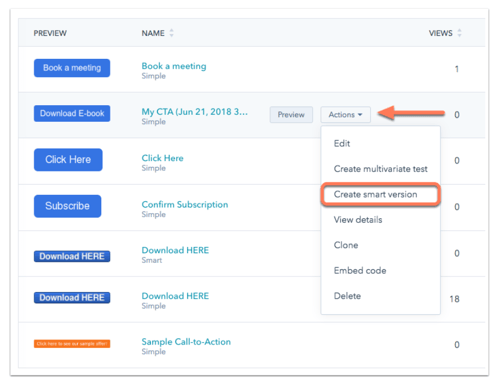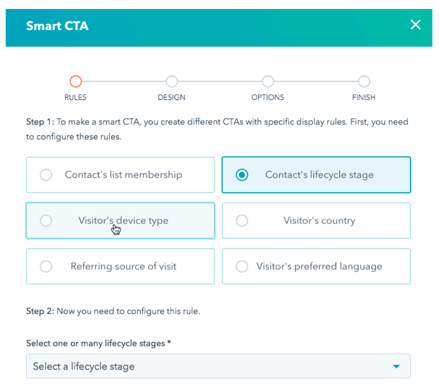What happens after a lead converts through one of your CTAs? Are they plagued with the same offer popping up on every article they want to read?
This is the case with most sites, causing you to miss opportunities for increased conversions and satisfied customers.
Well, Hubspot has a tool to change that. With Smart CTAs, they found calls to action performed 202% better than basic ones because of how relevant the offers are to their position in the buyer's journey.
This means you can meet your prospects with hyper-relevant offers, causing your conversion rate to skyrocket as customer get exactly what they need. And as a bonus, they're not difficult to use.
How to Get The Most From Smart CTAs
Smart CTAs are Hubspot's form of targeted calls to action. They allow you to set pre-defined parameters, and when they're met, the consumer will be presented an offer that's tailored to them.
Imagine your customer purchases your product, then arrives on your page to be offered a free trial. What good does that do them or you? A Smart CTA can see they've already converted and present them with an offer that moves them further down the funnel.
1. Establish The Rule
The priority task for creating Smart CTAs is setting "Smart Rules." These are what tell the system when to display a specific offer and serve as the baseline for what makes Smart CTAs so powerful.
Hubspot can use its software for something called Anonymous Personalization. When any visitor arrives on your page, certain information is publicly available. From their IP address you can gain their location, and you can find the device or referral source as well. This information feeds the Smart CTA engine with data from customers who haven't been to your site before.
For those that have been logged into your CRM, which they should be if they've converted on an offer, you can use characteristics from your lead's profile to further segment.
Smart Rules can be set for all the Anonymous Personalization data, but also content based on your contact list, and their lifecycle stage.
2. Plan the Steps You Want Leads to Take
Once you know the rules you're going to base your Smart CTAs on, you need to decide what the next step customers should take is. Assuming they convert on your offer, what data will you use to decide which is the next best fit for them?
What's important in this stage is that if they convert on an offer, you need to request the information that will move them down the funnel. For example, multiple customers may convert on an offer to help them build their marketing strategy. A required field in your form could be their company size. Now, the next offer can be more specialized with a focus on small businesses, enterprises, etc...
From there, you could further segment them for the right offer by requesting their industry, goals, or using data you already have, like their country.
Let your buyer personas act as your guide for initiating the path you think customers would take, and then validate it with the data.
A flow chart makes it easy to map out their journey with the various branches your rules create. The chart should acknowledge, if rule A is true, then offer Z, if rule A is false, then offer X. This is the best way to visualize a process that can get confusing with so many variations.
3. Create Copy that Fits Their Journey
If a Smart CTA is presented, it's because the consumer has already accepted a prior offer. And, because you know how they got there, you know what copy helped earn their first conversion.
So, rather than your copy making it appear as though it's your first interaction, you're able to provide something more personalized to the consumer. This could be as simple as mentioning the previous offer, to remind them they've opened a loop, or you could implement some of the data you've collected like company size or location to further connect.
With some initial work up front, you can create variants for each of your offers that work in tandem with the rules and nurture your customer along their journey.
4. Test Your Smart CTAs
Finally, Hubspot gives you the option to A/B test your CTAs. This gives you unlimited potential for finding the Smart Rules that best guide your customer.
The most effective tests will look at what data drives conversion on specific offers the most. To do this, you need to look at each stage of your Smart CTA. For example, two initial offers may have the same conversion rate, but the second has a dramatic drop off for one. Since the rules are the same for both, you can implement the higher performing CTA and start a new test.
Along with the rules, you should test the CTAs themselves to ensure your copy, imagery, and overall offer and doing their job. Smart CTAs are working to segment the audience to the best offer. If what you're presenting can't close the deal, it needs to be refined as well.
Guiding the Buyer's Journey with Smart CTAs
Smart CTAs are incredibly useful tools to add to your marketing strategy. If you can provide the offer that makes the most sense for each customer's next step in their journey, you'll find your conversions rates skyrocketing.
Hubspot offers Smart CTAs and many more tools for taking your marketing to the next level. And because we find them so valuable, we created a guide to help you save massive amounts of money in your first year.









